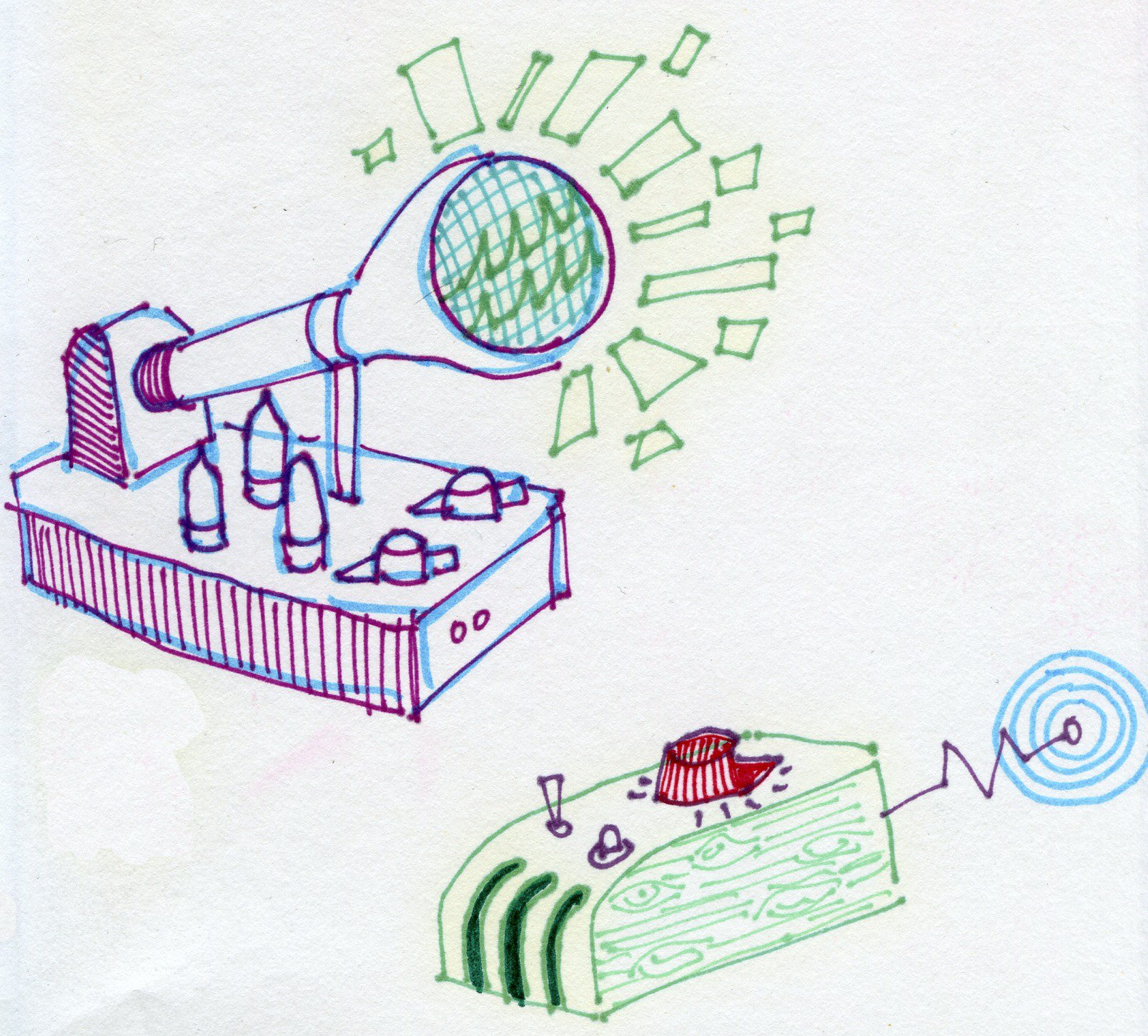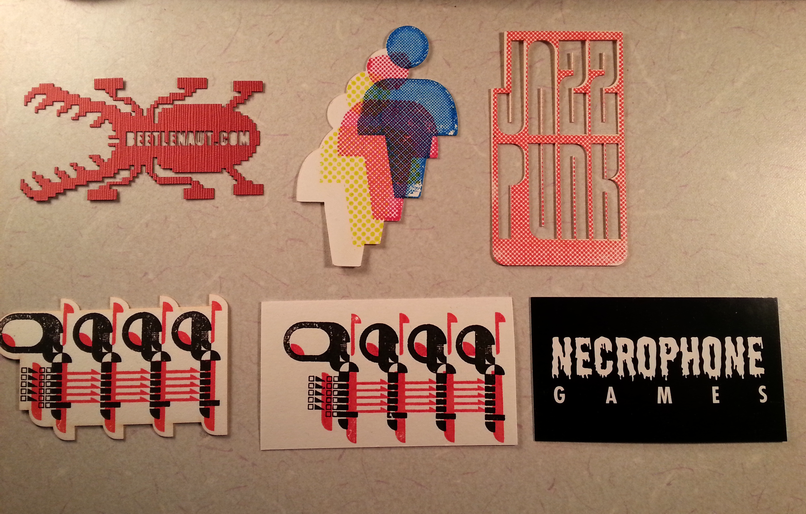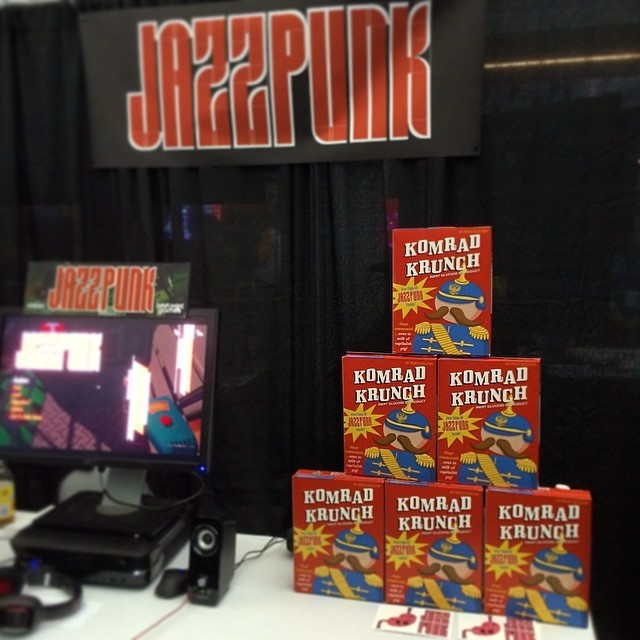Timeline of Interviews
(and other things)
Prior to Summer 2013: [DEAD LINK] Interview with SamaGames
January 20, 2013: Sup, Holmes? Ep 45 w/ Luis Hernandez, co-founder of Necrophone Games
July 17, 2013: Jazz Punk interview with Luis Hernandez
February 14, 2014: Indie Luchador vs Necrophone Games (Jazzpunk) – Indie Luchador Podcast - Spiderduck [Archived Link]
February 18, 2014: VGazzled 8
February 27, 2014: Road to the IGF: Necrophone Games; Jazzpunk [Archived Link]
March 13, 2014: IGF Factor 2014: Jazzpunk | Rock Paper Shotgun [Archived Link]
Sometime 2014: [DEAD LINK] Luis Hernandez - Jazzpunk by SweetJP
January 16, 2015: Why Is It So Hard to Make a Funny Video Game? [Archived Link]
April 10, 2015: Jim Sterling Interview: From Critic to Thespian in The Charnel House Trilogy [Archived Link]
September 21, 2015: Interview with Luis Hernandez of Necrophone Games [Archived Link]
June 11, 12, 16, 2016: Jazzpunk Wedding Qake Multiplayer Beta Testing! [Archived Link]
February 7, 2017: The Making of 300-1200 Baud Buyman [Archived Link???]
July 25, 2019: [DEAD LINK; only available via Archived Link] Jazzpunk: By Necrophone Games – VaporGames [Archived Link]
if i find another dead link i'm going to turn to dust
SINCERELY, POLYBLANK
Page Begun: 6/22/2024
Last Updated: 11/12/2024
Development
- Jazzpunk (a portmanteau of jazz and cyberpunk) was developed by Necrophone Games and published by Adult Swim Games. It released on February 7, 2014 for Windows, Mac, and Linux.
- Necrophone Games was founded in 2008 by Luis Hernandez and Jess Brouse.
- Their earliest known project was the mobile game Beetlenaut. It's unknown if they made other games other than Beetlenaut or Jazzpunk.
- In even later (around 2012) in development, Jazzpunk was stylized as Jazz Punk, JazzPunk, or JAZZPUNK in blog posts and news articles.
- Development began 2007-2008, as Luis Hernandez was inspired by Latin Exotica music. This was before the Unity game engine was released. During development, Jazzpunk switched engines or Unity versions. This broke textures; Hernandez was charmed by some of these errors, and incorporated them into the game's style.
- Luis Hernandez was in charge of art design, and Jess Brouse did programming. From known interviews and tweets, the bulk of Jazzpunk's aesthetic came from Hernandez. Both Brouse and Hernandez collaborated for jokes and shared a taste in aesthetics. If even one of them tired of a gag, it was cut.
- Jazzpunk was originally intended to be a serious noir game, but as early development continued, the developers realized their favorite parts of the game were the jokes. Thus, Jazzpunk was continued as a comedy game.
- Much of Jazzpunk was inspired by 1950s/1960s comedy, like the 1956 film Naked Gun. Its humor was influenced by Portal (which released in 2007). Jazzpunk's distinct artstyle was present since the beginning.
- Font: "Jazzpunk Display" in the files, directly inspired by the font Neutraface typeface. Neutraface was designed to be "the most typographically complete geometric sans serif family ever." Designed by modernist architect Richard Neutra, who was active in the 50s, where Jazzpunk takes place and where it draws most of its inspiration.'
- Necrophone Games was present during PAX East 2014, complete with some of the only known official Jazzpunk merchandise. These included business cards, Komrade Krunch (parodying Captain Crunch cereal), and t-shirts with the Jazzpunk logo. This is the only known time these items (shirts, memorabilia) were available, and according to Hernandez, demand was low, so there were never more items created.
- Jazzpunk's soundtrack was made using real period-accurate synthesizers. Hernandez would build(repair?) these synthesizers himself. Because Jazzpunk's OST was on actual tapes, and digitizing them would take "considerable effort," there had not been an official OST planned for years after the game's initial release. Additionally, many of these synthesizers are in-game as easter eggs. On Jazzpunk's 10-year anniversary, on February 7, 2024, Luis Hernandez released the Jazzpunk Original Soundtrack (which included unused songs) on Bandcamp.
Trailers
2012 Jazzpunk Teaser
- Perhaps the earliest public teaser for Jazzpunk released October 17, 2012. It has been since taken down from Necrophone Games' YouTube channel, but is still viewable via the Wayback Machine. It features an early version of the Jazzpunk logo.
- In contrast to other trailers, this one shows actual gameplay footage. All of the footage shown in the teaser is present in the final game.
Jazzpunks Are GO!
- Released November 1, 2013, in a now-deleted Necrophone Games video. It is unknown why the trailer was taken down (maybe a copyright strike?).
- It is a parody of the opening credits for the 1965 sci-fi TV series Thunderbirds. While objects and characters in the teaser feature in the final game, none of the scenes (the Director being shoved against a moving train, the Cowboy wielding guns within the Consulate) are in-game. These are scenes made just for the trailer.
- Interestingly, the model used for The Editor ("Antagonist") is his balloon model used at the climax of the game.
- The video's description states the game as coming out January 2014. (Jazzpunk released February 7, 2014.)
Jazzpunk: Johnny/Project Pigeon
- The entirity of the live trailer's production is preserved in a Flickr album created by the director, Don Thacker. This is also how its behind-the-scenes names, Jazzpunk: Johnny and Project Pigeon, are known. It was filmed around December 2013.
- The trailer's setting, Vera City, is a pun on the word veracity, defined as "conformity to facts; accuracy."
- The album wrongly labels the protagonist as "agent Polyblank," and it is unclear who made the mistake.
- Released January 23, 2014, perhaps first on the Adult Swim YouTube channel. Currently viewable outside of the Wayback Machine on the GameSpot YouTube channel.
- The protagonist of the trailer, played by Josh Truax. is not Polyblank, the protagonist of Jazzpunk. The protagonist is named Johnny on Josh Truax's IMDB page, and Luis Hernandez confirmed on Twitter that the character is a parody of the protagonist of the 1995 film Johnny Mnemonic.
- The trailer takes place in a Nakagin Capsule Tower capsule, a piece of Japanese Metabolist architecture built 1970 to 1972. Like other Metabolist structures, it was built to reflect organic growth; the aim of Metabolism was for humans to live in harmony with the natural world around them, encouraging organic shapes and long-lasting structures. The Nakagin Capsule Tower was intended for its rooms to be removed and transported to other capsule buildings, so people could move without having to pack up their things. Only one capsule tower was ever built, making it sort of pointless, and demolition began in 2022. The Nakagin Capsule Tower is also present in Ikayaki Alley, behind the Golden Lucky Electric Squid's cul-de-sac.
Flavour Nexus Trailer/300-1200 Baud Buyman/Project Switchhook
This trailer, released on August 25, 2016, announced the Flavour Nexus DLC and Director's Cut update. It was filmed and edited by Mayeda Studios, under Imagos Films, the same studio that produced the first live action Jazzpunk trailer. Notably, the studio also produced a behind-the-scenes video detailing the work that went into it.
This BTS video shows a multitude of props made for the film, and how the practical effects were pulled off. (Unfortunately, the production video reveals that the Director's physical prop is entirely uncensored.) The cast listed in the BTS are:
- Don Thacker ★ -- Writer and Director
- Scott Larkin -- 1st Assistant Director
- Bliss Holloway ★ -- Director of Photography
- Megan Lacki -- Costume Designer
- Allie Pratt -- Actor (Bored Cashier)
- Ryan Ike -- Composer
- Notably, he is the one who refers to the project as Project Switchhook. This title is also visible in the file names on the computer.
- Ian Hubert ★ -- Visual Effects Supervisor
- Vanessa Williams -- Editor
- Brendan Hogan ★ -- Sound Mixer
- Jamie Hunsdale ★ -- Foley Artist
- Jeffry Kazuo Mayeda ★ -- Filmer and Editor
Names with a star (★) are listed as having also worked on Project Pigeon.
The Don Thacker Email
On October 27, I emailed Don Thacker about the work he did for Jazzpunk, and asked if he'd be willing to answer some questions about the development of the trailers. He said he'd be happy to. On November 4, he answered. This includes details about working with Necrophone Games, behind-the-scenes information about the trailer development, and the scripts, "as a gift."
Thank you, Don Thacker.
Full Response here:
How did you start working with Necrophone Games, and what was it like? Did you work more with Luis Hernandez or Jess Brouse more?
Jazzpunk was originally brought to Imagos through Adult Swim Games. We had done several live action spots for ASG and I think the Necrophone Games guys may have seen something they liked? Most publishers we work with regularly basically lay out a marketing strategy and we're on the menu. "Do you want something from these guys," kind of thing.
At the time, we were an agency of record for ASG, and they put us together. To ASG's credit, they mostly stepped out of it once NG and Imagos were working together, though. It was an incredibly cool deal from them.
All of our work with ASG was like that; they would come to us with a project or a nugget of an idea and say, "go wild!" and we would, of course, go our particular brand of wild.
The Jazzpunk IP moved away from ASG, or at least the marketing side of it did, between the first spot, "Johnny," and the the second spot, "300-1200 Baud Buyman."
To both ASG's credit and NG's credit, the process was prettuch the same both times: awesome.
Did you work with Hernandez to compose the soundtracks?
Not at all. All in-game music was done without any influence from Imagos, and Imagos commanded the entirety of the music side for live action. Obviously, NG had notes/ input, but the two worlds remained mostly separate.
This is actually intentional most of the time that Imagos does a live action spot. We need to keep the game proper and the hyper-splatter of crazy images in the marketing close enough to be causally related, but distant enough to neither give away the experience you would get from playing a game or try to express in 90 seconds what a game takes 90hrs to say.
How much free reign did you have over the creative direction?
This is an awesome question for this project in particular. NG was the most hands-off absolute dictatorship we have ever worked with IN THE VERY BEST POSSIBLE WAY.
Essentially, they hit us with a hundred thousand little details and asked us to go ham and cheese on them. They were open to almost every one of my wild pitches, but the details were fine tuned by them to an incredible degree.
Imagos's process, when asked to pitch a story for a spot, is to put together a deck of several ideas that we feel would best serve the project and present them as a menu from which a client can choose ideas from; even mix and match elements from all of the presented ides (which happens). We do this to limit the infinity of choice. It helps with clients who don't know exactly what they want, but know things they DO want, and know very clearly what they don't want.
The NG pitch wasn't like this at all. I had a few lightning strikes and we hopped onto a video conference and I just ranted a bunch at them about my weird concepts and they rolled with them almost immediately. It was in the details that they really pushed hard to make sure what we were doing was going to live in the world of Jazzpunk.
Looking into our archives, I see the notes we came up with during those meetings. Here they are, pasted:
Pitch 1
- Noir detective enters office/closet
- Pulls out briefcase
- Gun, parabolic mic, bluebox
- Banana, lobster, blender, ping pong ball
- Dumps a pile of cardboard hands
- "I'll be there in 10 minutes."
Pitch 2
- Keanu reeves enters facility
- "I've got to check my email"
- puts on helmet, gloves, puts bit into his mouth
- "hit me"
- seizure
- cut into: checking email, facebook, etc
Pitch 3
- [Look Around You - but 1960s]
- 1960s style educational video
- "the computer, invented in 1932 by James Bromely--"
- "robots are used in many homes for--"
As you can see, we used a lot of bits from those. As I've said, this is 0% how we usually ptch. Usually there's a whole proposal with notes on tones and imagery and stuff.
With Necrophone, we just jammed. Again, in the best way possible, they were tyrannical in their attention to detail, and both spots (Johnny & 300/1200 Baud Buyman) only work as well as they do because of it - but the initial ideas were open to creative freedom.
Do you still have the storyboards?
We didn't board Johnny - we listed. The time and money didn't really allow for it.
I worked with the same Cinematographer on both Johnny and 300/1200 Baud Buyman, one with whom I had collaborated on several commercial projects as well as a feature film before this point, so we had a bit of a shorthand going. We made shotlists and went into the day with a clear vision once we saw the set.
The set took seven days from concept to film ready. It was built in front of a greenscreen cyclorama, so the outer windows could show through to the city, TOKYO DUO. It was an incredible endeavor from a production designer I had worked with on some other ASG spots (and more), and it benefited heavily from his understanding of the Imagos look. It was entirely built, with wild walls (we could move any wall at any point) and an incredible level of set dec.
Once the DP and I stepped in, we knew the lists would work and we just went wild.
For 300/1200 Baud Buyman, we used a practical location (the interior of a grocery store) and boarded some of the action for clarity. Not as much as we'd board normally, but, again, the budgets for both of those spots was limited, and the timelines so short, that boards were a luxury we didn't get to play with widely.
Here is a set from 300/1200 Baud Buyman:
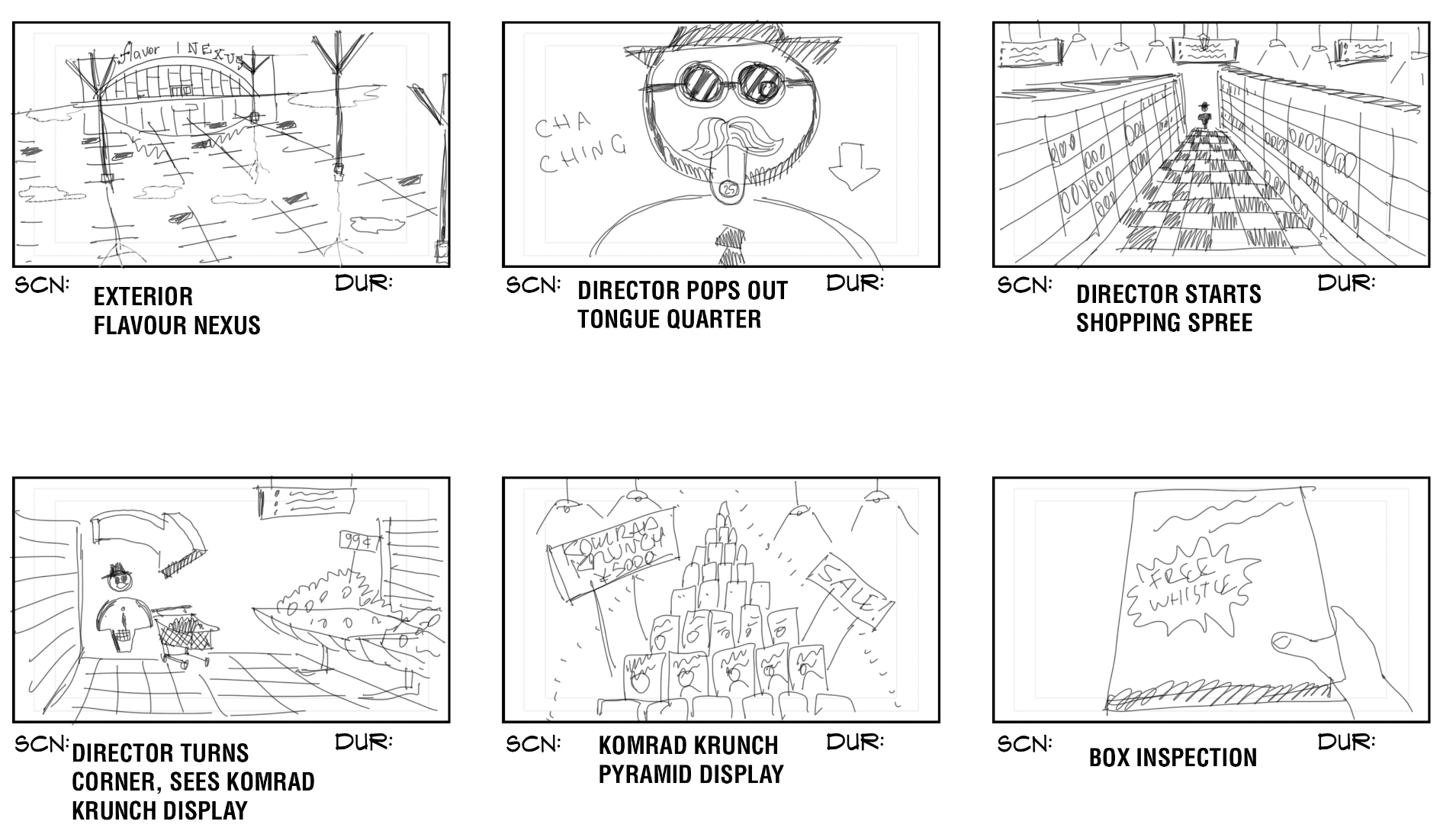
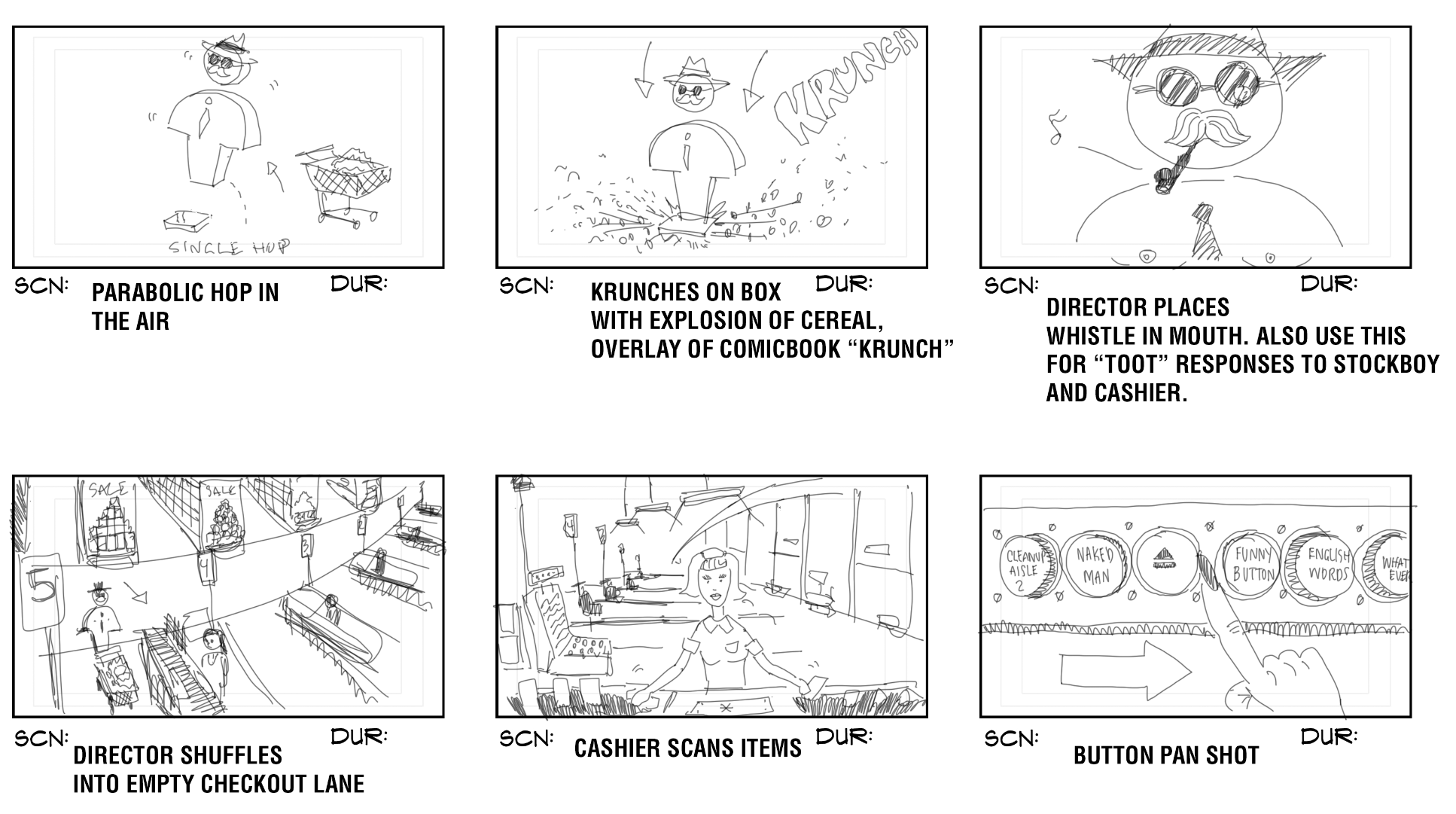

Was there anything planned that didn't make the final cut?
For Johnny, only one beat; a comedy beat where the agent gets all geared up to CYBERJACK INTO THE NETRIX and then we hit a cold drop. He's forgotten to push the button. Then he pushes the button and it's ON LIKE TRON.
I think we cut this beat as redundant. Once we got to filming, it felt a lot like cyberjacking into the netrix was going to be enough. Watching him unwrap the thing and follow all but one instruction felt like it might be dead space.
That, or we just ran out of time. That's always an option in production.
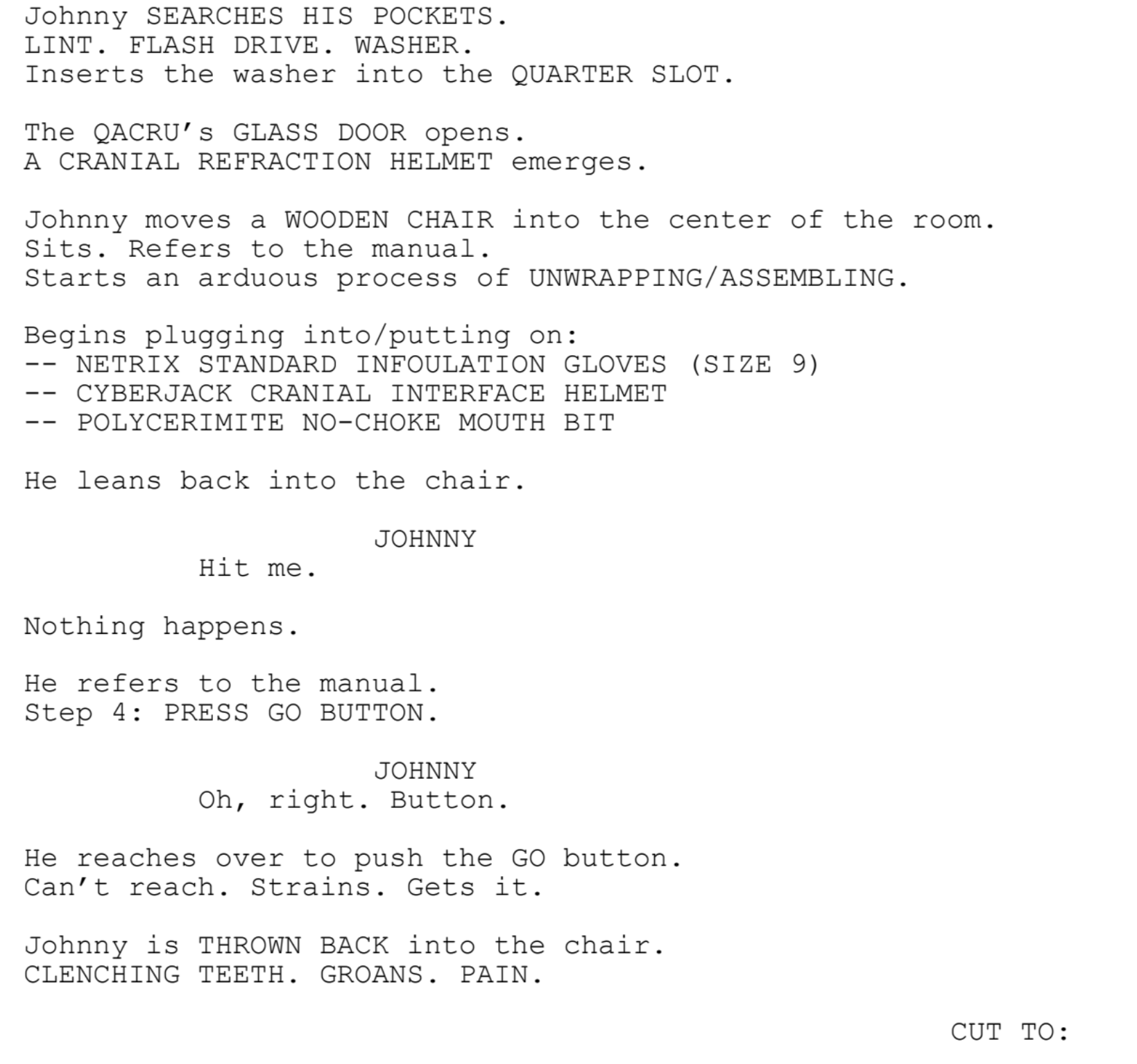
Otherwise, it was all 1:1 the script.
For 300/1200 Baud Buyman, nope. Nothing. We shot what we wrote :) Well, we didn't do the tongue quarter gag.
Interesting note for 300/1200 Baud Buyman: The split-screen section, with The Director talking to the Cashier in one frame, was entirely a practical, in-camera effect!
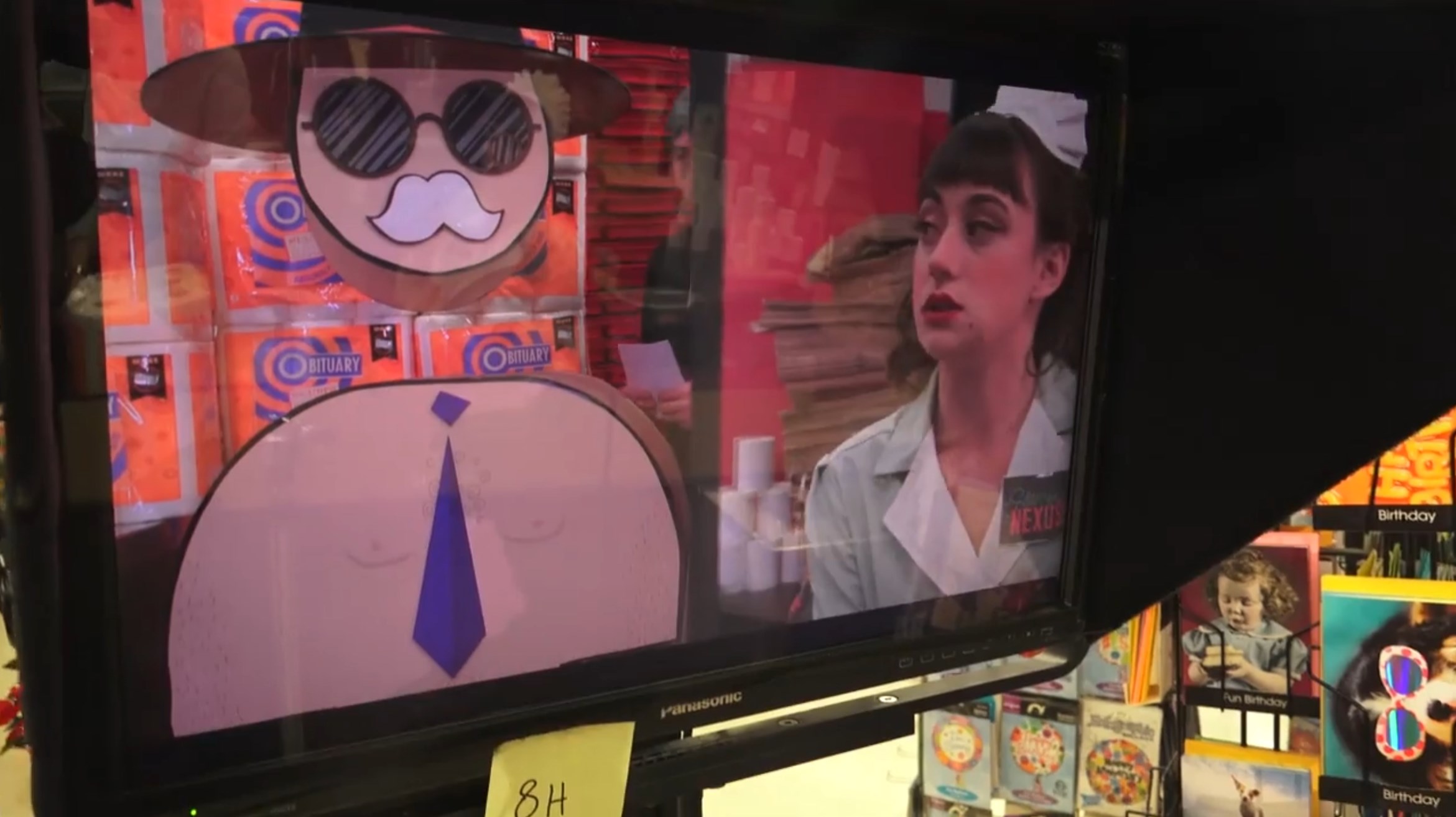
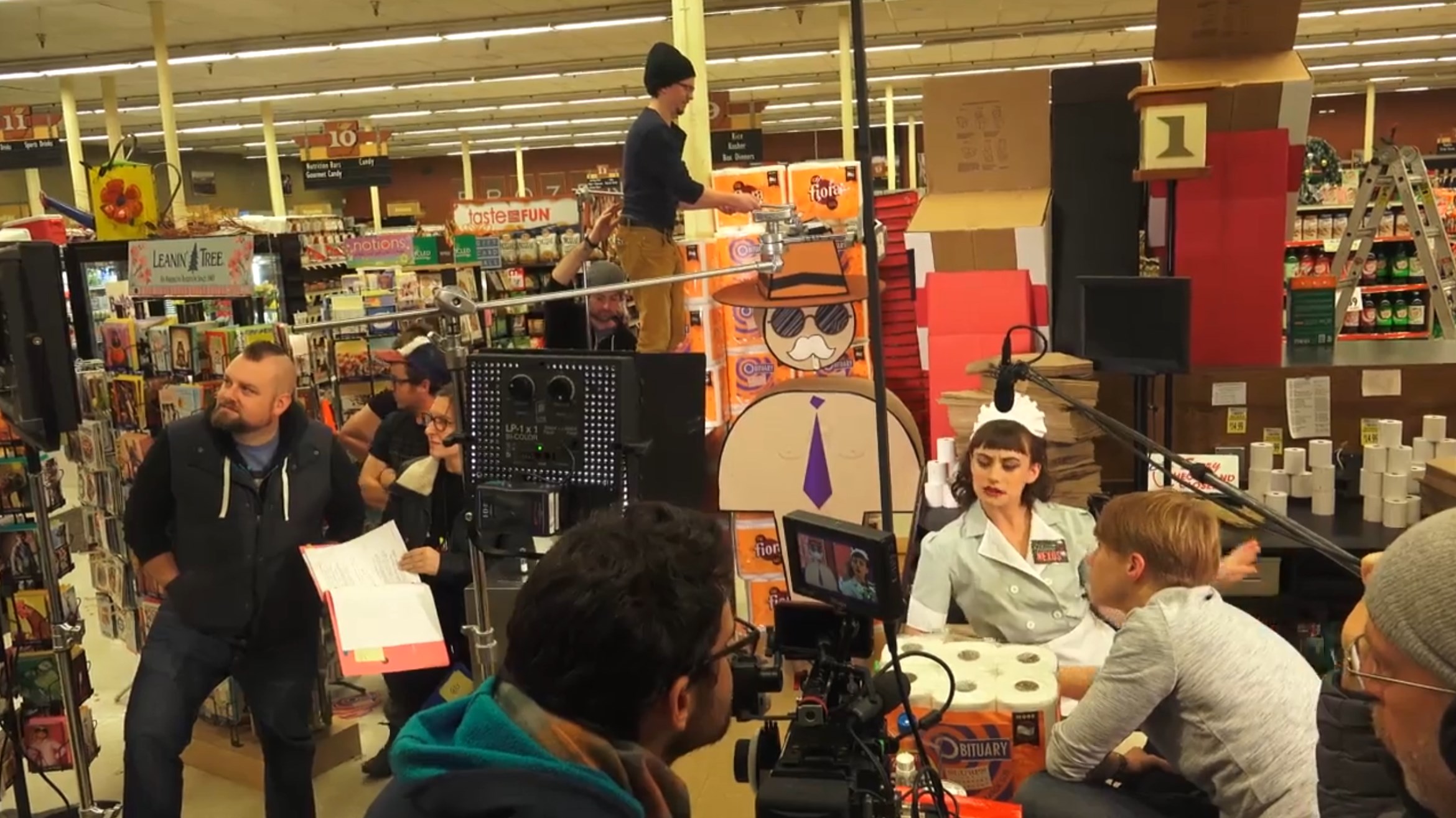
What happened to the props and spoof items used?
For Johnny:
The CRANIAL REFRACTION HELMET was destroyed. Several of the parts that made it into that beast were either rental bits or owned by one of the crew/creatives. The rest was auto butyl and bits of rubber and piping and stuff.
The set was struck and, as with the helmet, the bits went to their respective owners or the trash. Even the wall flats.

The stuff in the attache' case:
- The prop pistol was returned to the armorer.
- The POLYBLANK POINTING HANDS hands
- The parabolic microphone lives in a storage unit with select props from other projects.
- Sadly, the pigeon is likely dead. It was a well taken care of racing bird, fully trained and treated like royalty, but they don't live very long and it's been more than a decade :/
- The 2600htz whistle was kindly donated to the project by an unnamed source whose possession of it I will neither confirm nor deny. If you wonder what this means, look up 2600hz cap'n crunch whistle on the intertron.
We're especially curious about the fate of the Director prop(s).
For 300/1200 Baud Buyman, The Director was made out of foam board, and, unfortunately, didn't survive the transition into present time.
The rest of the set dress and props are, as well, all disposed of. Except for a giant cereal box front, that lives in storage.
I'm also curious about any remnants of old PAX East 2014 props and merchandise, but that might've been more in Necrophone Games' hands than Imagos Films'.
All of that is with NG. The only thing we had to do with their presence at PAX was a few pictures of us stopping by their booth and bumming around with them.
The 2014 trailer is called Project Pigeon in the Flickr album documenting the set. In the 2016 trailer's behind-the-scenes video, the composer Ryan Ike refers to it as Project Switchhook. Who named them and how were the names chosen?
Imagos has a tiered naming structure for commercial projects:
CLIENT -> PRODUCT -> PROJECT -> TITLE
CLIENT = Client (obviously)
PRODUCT = Thing the spot is about
PROJECT = The specific spot. We may do several spots for one product, so this is how we differentiate.
TITLE = The actual spot title.
For the FIRST Jazzpunk spot, the breakdown is like this:
CLIENT = Adult Swim Games / Necrophone Games
PRODUCT = Jazzpunk
PROJECT = #projectpigeon
TITLE = Johnny
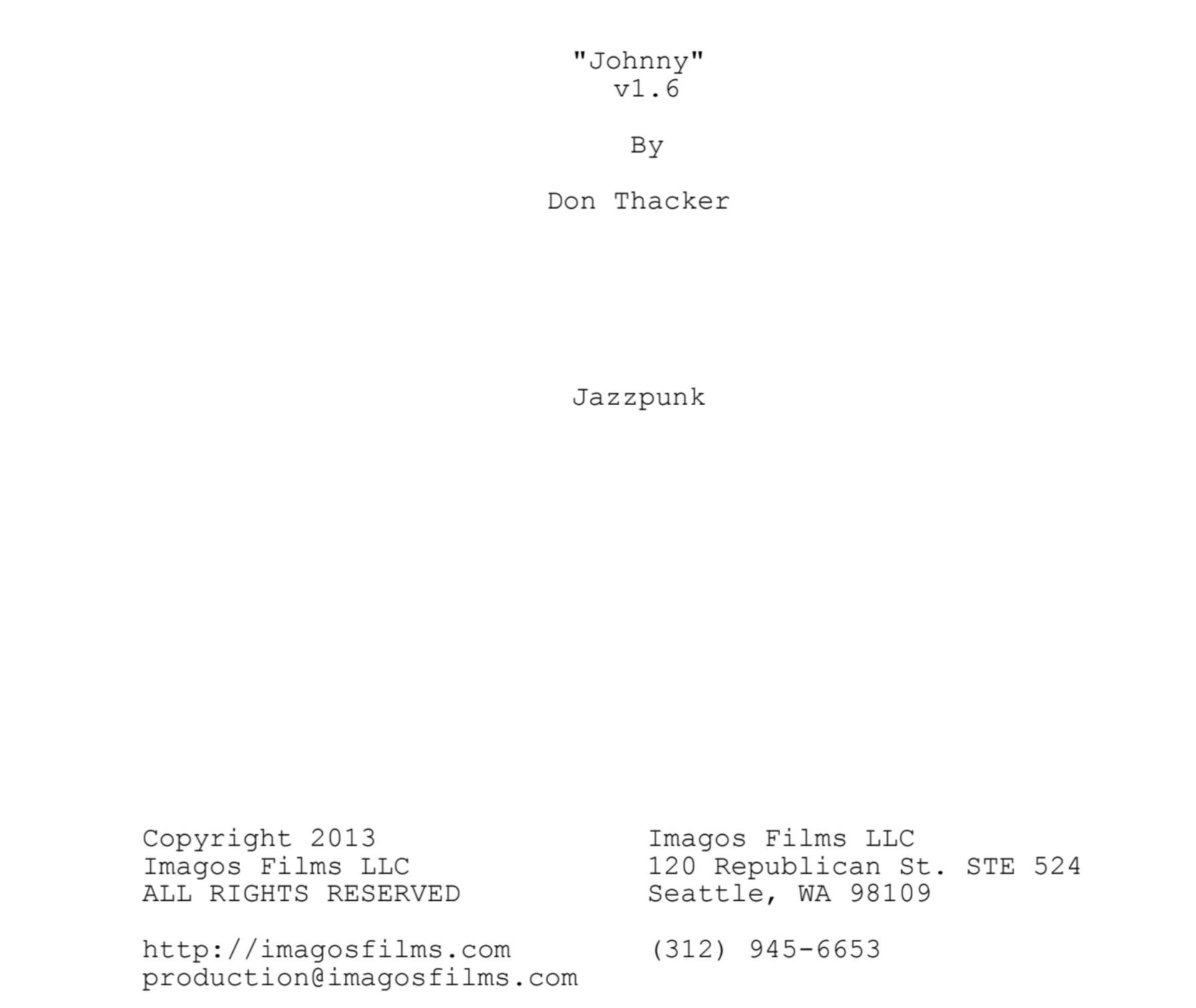
For the SECOND Jazzpunk spot:
CLIENT = Necrophone Games
PRODUCT = Jazzpunk
PROJECT = #projectswitchhook
TITLE = 300/1200 Baud Buyman
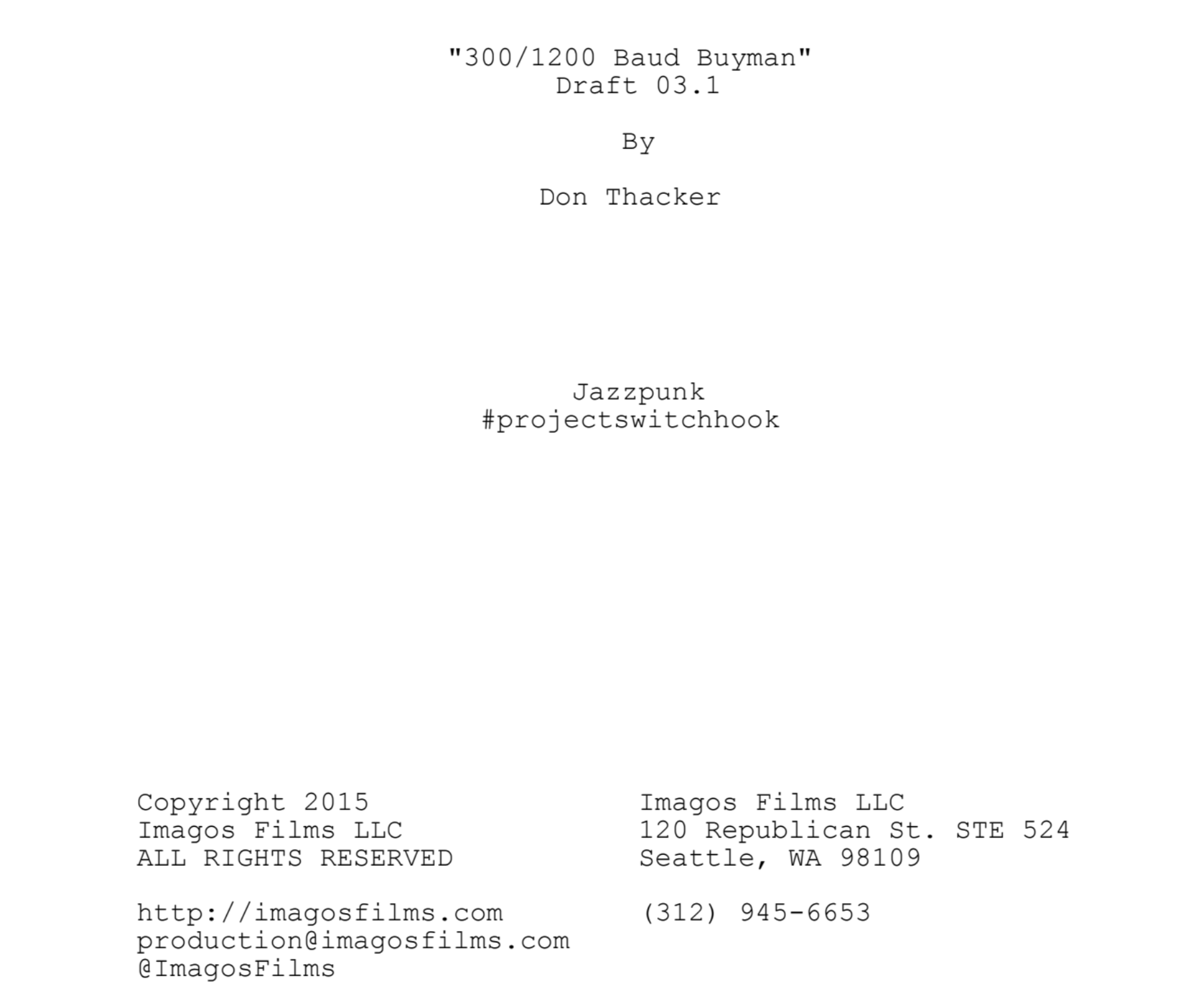
Who named them and how were the names chosen?
Anything you see with a "#project" prefix is the PROJECT name. These project names tend to be silly or abstract. This is mostly because some of our projects need to be secret as we shoot them.
I write all of our work, and, as such, name the projects. Much to the confusion and frustration of my business partners :)
In the 2016 trailer's behind-the-scenes video, the composer Ryan Ike refers to it as Project Switchhook.
A switchhook is an old phone term. It was a physical switch set into a hook for hanging your receiver on. It was an analogue electrical circuit, and could be manipulated by phone phreaks to, you know, DO TEH HACKINGZ.
Similarly, where did the other title for the 2016 trailer, "300-1200 Baud Buyman," come from?
A baud rate is the rate at which a modem transfers data. Analogue modems used to use these baud rates as indicators of speed or bandwidth, in marketing, much as modern broadband connections use megabit or gigabit ratings.
Without getting too technical, analogue modems transfer data as 1s and 0s by flipping signal frequencies to represent state changes. This is the dumbest way to say this, but a baud rate of 300 means that 300 signal changes can take place per second of connected time. 1200 baud is 1200 signal changes per second.
A top of the line phone modem in the late 80s/early 90s could band between 300 and 1200 baud. Kingmakers and 1337 h4x0rz might have been able to convince their parents to get into a 1440 baud modem. If they were lucky.
This is all pre-millenium phone phreak/hacker stuff. I was exactly the right age, in exactly the right place to have been swept up into all of that as my form of teenage rebellion.
The Jazzpunk world is a cyberpunk inspired pre-digital hackerverse, and I grew up in the height of that, and leaned on those things for the scripts.
The Director is jumping though time, buying goods at a low price and selling them at a high price in the future. In the spot's narrative, that's how the entire endeavor is being funded. He is, however, causing massive inflation in the process.
And he's using a 300/1200 baud modem to transfer himself back into the past, because that is the technology that existed.
#projectpigeon is named such because the pigeon. In the spot. The spot has a pigeon in it.
The 2016 trailer's IMDB page lists someone named Chris Morson as the voice actor for the Director. Is this true? Additionally, do you happen to know who voiced the Editor in the game, or any other voice actors?
Chris is an INCREDIBLE actor. I've worked with him several times, and every one of them has been incredible. Yes, he plays the voice of The Director in the spot, but has nothing to do with the game.
As well, I also have/had nothing to do with the VO in the game. A shame, because I would be super proud if I had!
Did you/Imagos Films make anything else for Jazzpunk?
Unfortunately, no. I would love to, of course. That series of spots is truly a wonderful time.
I have attached the script for both Johnny and 300/1200 Baud Buyman as a little gift. Enjoy.
Chapters
Darlington
- Modeled after Ossington Station of Toronto, Ontario, Canada.
- Darlington's font is also inspired by the typeface Toronto Subway. The font was made from scratch. (It seems to be the same Jazzpunk Display used in the rest of the game?)
The Soviet Consulate
Modeled after Googie architecture: Popular from the 40s to the 70s. Characterized by curved shapes, bright colors, Space Age/sci-fi imagery, mid-century modern architecture, and links to the populux aesthetic. Googie architecture is also present in Kai Tak Resort and Flavour Nexus, but first appears in-game in the Consulate.
Originally, the Consulate's top bulbs would have been transparent to show internal filaments, but this was cut because Luis Hernandez found the design "too busy".
The Consulate's pillars were inspired by similar pillars in Blade Runner.
The Koi Pond
Ikayaki Alley
- Extremely inspired by Blade Runner and grunge aesthetics; its architecture draws from Kowloon Walled City, a dense cube of unregulated architecture in China.
- The Nakagin Capsule Tower can be seen in the distance, past the end cul-de-sac.
The Temple
The Expedition
Kai Tak Resort
Flavour Nexus
A DLC released September 20, 2016. Originally intended to be the transition between Kai Tak's Day and Night chapters. The Flavour Nexus store is directly modeled after the real store Penn Fruit.
Kai Tak Resort (Night)
The Wetworks
The Wetworks was originally going to be a mission designated to the player by the Director.
Note: The video clip a TVhead displays is the opening clip from 1968 informational film "The Incredible Machine" by Bell Laboratories.
Bachelor Pad
HEAVILY inspired by background art drawn by Scott Willis for the 1996 cartoon short Buy One, Get One Free.
Intestinal Credits
Mini-Games
Deserving of its own section; Wedding Qake used to be called Wedding Cake, but was renamed to Wedding Qake in the Director's Cut update. Self-explanatory. Joe's ThinkPizza is based off Silent Hill.
